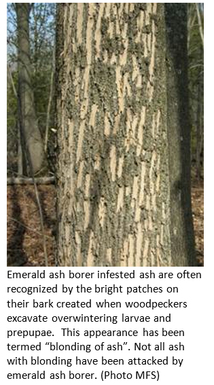|
The emerald ash borer (EAB), Agrilus planipennis, is one of the most
serious invasive species threatening our ash resources and forests. All species
of ash that grow in Maine are susceptible to injury and death by the emerald
ash borer. EAB was first found in Michigan in 2002. There are currently known EAB
infestations in 31 states and three Canadian provinces. The closest
infestations to Maine are in New Hampshire, Massachusetts and Quebec. This
insect has not been discovered in Maine yet.
Recently, the Canadian Food
Inspection Agency announced a significant expansion of their EAB quarantine
area. The expansion is particularly
relevant in Maine because the boundary of the regulated area in Canada now
covers most of our western border south of the Aroostook County line. The border crossing in St. Juste is less than
10 miles north of the new boundary. Although EAB has not yet been detected in the regulated jurisdictions of
Québec immediately adjacent to Maine, it was found outside the formerly
regulated area in several locations along the Saint Lawrence as far east as
Québec City, and south to Sherbrooke, QC last season. We have contacted our Québec counterparts
requesting information regarding their plans for managing the infestation, and
what steps they are taking to slow the spread within the expanded regulated
area.
Emerald Ash Borer Quarantine Areas in the Northeast as of January 2018.
With new finds of EAB ever closer to Maine’s borders (in both New Hampshire and Québec), monitoring continues to be very important. Success in slowing the spread and managing impacts will hinge on early detection and response. Maine Forest Service (MFS) and our partners use several methods to monitor for emerald ash borer including trapping, visual surveys, trap trees, biosurveillance, outreach and education, and following up on reports from the public. The effectiveness of these detection efforts depends heavily on cooperative support and involvement from you.

Emerald ash borer infested ash are often recognized by
the bright patches on their bark created when woodpeckers excavate
overwintering larvae and prepupae. This appearance has been termed "blonding of ash." Not all ash with
blonding have been attacked by emerald ash borer. (Photo MFS)
Thank you to everyone who has participated in our ash trap
tree network. If you girdled trap trees in the spring of 2017, please
plan to get your trees to one of our log-peeling workshops. We’ll be holding one in Augusta, at the MFS
Bolton Hill facility on Wednesday, Feb 21. A second workshop at Acadia National Park will take place shortly
thereafter, exact date to be determined. More information, including instructions
for felling and sectioning your tree, will be coming soon. If you girdled
a tree but do not hear from us within a week, please contact Patti Roberts to
be sure you are on our mailing list [patti.roberts@maine.gov,
(207) 287-2431]. Similarly, if you did NOT girdle a tree but are
interested in coming to one of the workshops, please contact Patti and we will
send you the details.
This spring and summer the Maine
Department of Agriculture, Conservation and Forestry will work with USDA-APHIS,
PPQ and other partners to augment current trapping plans informed by this
recent development.
Meanwhile, you can help us look
for this pest. Although the highest risk
for introduction of EAB is close to current infestations, all of Maine is
vulnerable to introductions due to the insect’s ability to spread in infested
firewood. Winter is an excellent time of
year to be on the lookout for EAB-infested trees. Look for ash with "blonding" due to
woodpecker activity. These trees may be host to EAB. For more information about
blonding, follow the top link for "Blonding on ash" from this website: http://nhbugs.org/emerald-ash-borer.
To report suspected EAB damage
and for more information please visit: www.maine.gov/eab.
For more information about the Divison of Forest Health and Monitoring:
http://maine.gov/dacf/mfs/forest_health/index.htm
|
|